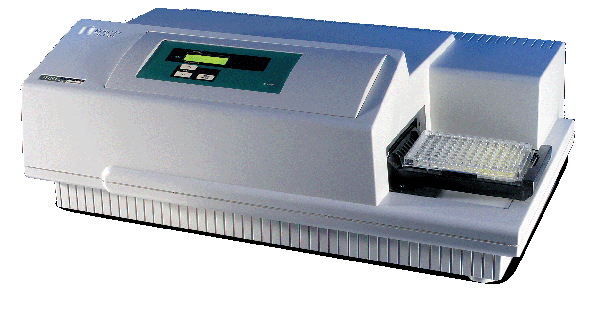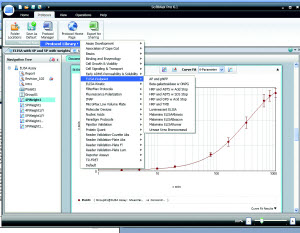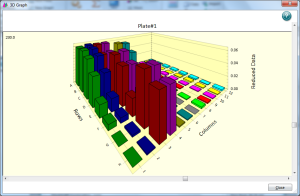
A powerful, affordable catalyst for scientific accomplishment
Make the most of your budget with the VersaMax™ ELISA Microplate Reader, our affordable, visible spectrum absorbance reader for 96-well microplates. This richly featured reader gives you the speed, convenience, and economy of monochromator-based wavelength selection for visible absorbance measurements between 340 nm and 850 nm, so you can accomplish more, with less.- Overview
- Applications
- Software
- Specifications
- Resources
- Eliminate the need for purchasing and changing out filters for wavelength optimization with a monochromator-based wavelength selection for visible absorbance between 340 nm and 850 nm
- Read up to 2 wavelengths in endpoint or kinetic mode for 96-well plates
- Report results with confidence: Patented multichannel optical design mimics a dual-beam spectrophotometer, measures each sample in the plate directly, and eliminates error due to variations in light output between optical fibers on other instruments
- Monitor temperature-sensitive reactions with consistent temperature regulation from ambient to 45°C
- Mix samples thoroughly in microplate wells with user-programmable Automix feature
- Analyze data using SoftMax® Pro Software comprehensive data analysis software
- Automate seamlessly with the StakMax® Microplate Handling Stacker
Microplate Reader Validation
- Comprehensive validation toolset available includes:
- SpectraTest® ABS1, FL1, and LM1 Validation Plates for hardware validation of absorbance, fluorescence, and luminescence modes,
- SoftMax Pro Software validation package
- Software tools for FDA 21 CFR Part 11 compliance
The VersaMax Microplate Reader supports a multitude of absorbance assay categories including:
- Cell viability, proliferation, and cytotoxicity
- ELISAs and immunoassays
- Endotoxin detection
- Enzyme assays
- Protein quantitation
- Microbial growth
- Phosphotases/kinases
- Reporter gene assays
SoftMax Pro Software simplifies setting up your assays by providing:
-
- Simple set-up and automatic instrument recognition
- Pre-defined protocols for endpoint and kinetic ELISA protein plus quantification assays such as Bradford, Lowry, BCA, and DC protein assays
- A wide variety of scan types: Endpoint, Kinetic, Spectrum* and Well Scanning*
- Standard data reduction settings are preselected as default
- Automatic data recovery feature

SoftMax Pro Software offers a variety of customizing options:
-
- Predefined calculation options for common data analysis functions
- Automatic export to Microsoft Excel
- Instrument settings and plate read area can be adjusted to suit your experiment’s needs
- Custom data reduction settings can be selected for optimal signal selection
- Full reports, with font flexibility, and live mini-tables and graphs are now available within the Notes section to simplify the result sharing experience
- Contemporary user community enabling protocol exchange and expertise sharing among our numerous users

- Proven integration with leading automation and LIMS platforms for partnered solutions
- Optional tools for regulated labs with SoftMax Pro GxP Compliance Software
* available in select instrument models
| General Specifications | |
| Dimensions (in.) | 8.6 (h) x 22.8 (w) x 15 (d) |
| Dimensions (cm) | 22 (h) x 58 (w) x 38 (d |
| Weight | 30 lb (13.6 kg) |
| Power Source | 90-250 VAC, 50/60 Hz |
| Performance Specifications | |
| Wavelength Range | 340-850 nm |
| Wavelength Selection | Monochromator, tunable in 1-nm increments |
| Wavelength Bandwidth | ≤ 2.0 nm full width half maximum |
| Wavelength Accuracy | ± 1.0 nm across wavelength range |
| Wavelength Repeatability | ± 0.2 nm across all optical channels |
| Photometric Range | 0.000 to 4.000 OD |
| Photometric Resolution | 0.001 OD |
| Photometric Accuracy/linearity | <± 1.0% and ± 0.006 OD, 0.0-2.0 OD |
| Photometric Precision | <± 1.0% and ± 0.003 OD, 0.0-2.0 OD |
| Stray Light | ≤ 0.07% at 340 nm OD ≥ 3.15 |
| Light Source | Xenon Flash Lamp |
| Microplate Read Time – Endpoint | 9 seconds |
| Microplate Read Time – Kinetic | 9-second minimum interval |
| Temperature Range | Ambient + 4 °C, to 45 °C |
| Temperature Uniformity | ±0.5 °C @ 37 °C well-to-well |
Related Collateral
Data SheetVersaMax Microplate Reader
Brochures
Microplate Reader Products
Applications
Microplate-based endotoxin testing in GLP/GMP environments using the pyrochrome assay
